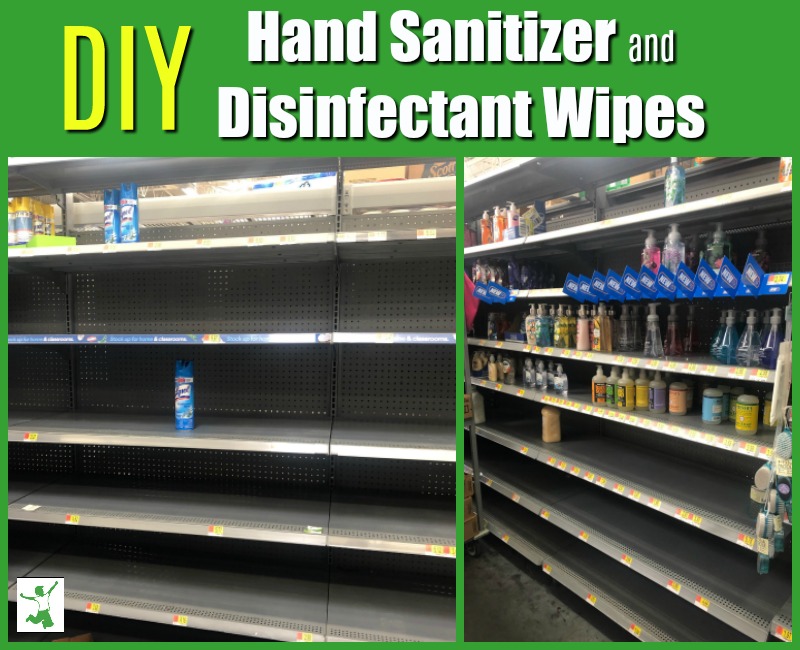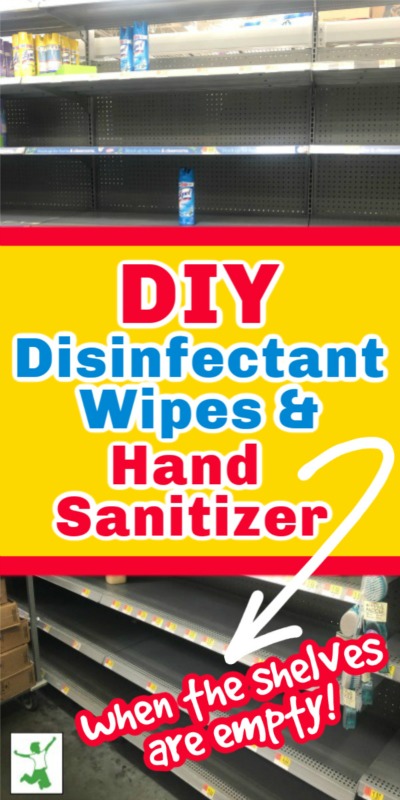Table of Contents[Hide][Show]
How to economically make homemade hand sanitizer and disinfectant wipes according to a Chemistry PhD to save money or in case stores run low on supplies during an epidemic.
The governor of my state announced the first two cases of coronavirus yesterday, and one of them happens to be in my community. The news alarmed a lot of people because, by dinnertime, supermarket shelves were nearly stripped bare of disinfectant, disinfecting wipes, hand sanitizer, and other related products!
I imagine that a similar scenario may be coming to a Wal-mart, Target or supermarket near you in the near future if it hasn’t already.
If the run on disinfecting products causes you to run short, no worries!
You can easily whip these products up yourself if you plan to be wiping down surfaces, doorknobs, and bathrooms more often than usual.
Going DIY will also cost you a lot less per use than the pre-made stuff at the store.
According to chemistry expert, Anne Marie Helmenstine, Ph.D., the active ingredient in homemade hand sanitizer should be 99.9% alcohol when mixed with aloe vera gel. (1)
Avoid substituting lower strength alcohol, hydrogen peroxide or witch hazel (which is fine for DIY baby wipes). The resulting mixture won’t produce a rapid enough anti-microbial effect if diluted with aloe vera gel. Lower strength alcohol should be used alone.
In other words, the total alcohol content needs to comprise at least 60% of the sanitizing mixture to be considered an effective disinfectant. (2, 3)
One more tip. If you choose to make your homemade disinfectant wipes with reusable materials such as bamboo paper towels, be sure to launder in hot water!
Anti-Microbial Essential Oils
If you choose to add the optional essential oils to the recipe below, I would suggest using ones that have anti-microbial properties of their own such as clove, thyme or tea tree. Use only 2 drops per batch with these stronger oils to avoid any risk of burning the skin.
If you choose essential oils such as vanilla or lavender purely for fragrance purposes, use 8-10 drops per batch.
Homemade Disinfecting Wipes and Hand Sanitizer
Make your own disinfecting wipes and hand sanitizer for pennies. Made with nontoxic ingredients with reusable paper towels option for safe, convenient sustainability.
Ingredients
- 1 roll paper towels HealthyHome15 for 15% off
- 2/3 cup 99.9% isopropyl alcohol
- 1/3 cup aloe vera gel preferably organic
- 2 drops anti-microbial essential oil optional (clove, tea tree, or thyme suggested)
Instructions
-
Mix the alcohol, aloe vera gel, and optional essential oil together in a glass jar to make a gentle but highly effective disinfectant. Pour into a cleaned, recycled hand sanitizer bottle. To make wipes, continue with additional steps below.
-
Cut each paper towel in the entire roll into four squares.
-
Make two stacks of the cut paper towels in a large glass bowl and pour the alcohol mixture evenly over them. Let stand until the liquid is fully absorbed.
-
If you find you need more liquid depending on the thickness of the paper towels you are using, mix up more alcohol/aloe vera mixture at a ratio of 2:1
-
Place the wipes in a large ziplock bag for convenient use at home or when traveling.
-
If using bamboo paper towels in order to re-use, store used wipes in a separate double seal ziplock bag for easy laundering as needed.
Recipe Notes
Make three batches of disinfectant wipes so that you have plenty of time to launder before you reach the end of the third bag.
In a pinch you can use ethanol or even 190 proof vodka to make your hand sanitizer or wipes.

References
(1, 2) Helmenstine, Anne Marie, Ph.D. “How to Make Homemade Hand Sanitizer.” ThoughtCo, Mar. 2, 2020, thoughtco.com/make-your-own-homemade-hand-sanitizer-606145.
(3) CDC: Guidelines for Disinfection and Sterilization in a Healthcare Facilities








Very timely post. Been scouting the internet for this, thank God I finally found it.
We’ve recently started our new eco-friendly janitorial service company and came across this article. I really appreciate you taking the time to educate us on this. I would never have thought you could use 190 proof vodka to make disinfectant, but it makes perfect sense. Thanks so much.
So I have 99.9% Isoproply Alcohol and Aloe Gel Which has 91% Organic Content. Attibutes Vegan – Paraben Free and I’m getting the goopy rubbery white rubbery looking stuff too. I’m mixing 1 part Aloe and 2 parts Alcohol. Mt first question is..can I somehow get these to blend nicely? And if I can’t, is this sticky part okay to use on my hands anyway? It feels kinda soft so I thought maybe it won’t look pretty but would it still be okay for my hands? Or does this ruin my hand gel completely? I also have Xantham gum but I haven’t adding any of that. Would that help thicken and make the consistency any better by blending it all together? I hate to waste my recipe because getting these items took forever. Thoughts?
You need to use pure aloe vera gel.
Hi Sarah,
I’ve got 91% Isopropyl alcohol and Aubrey Aloe Vera gel the alcohol seems to turn the aloe into a fibrous blob. I don’t know how else to dilute the alcohol or what is going on.
The chemist who devised this recipe says to use 99.9% alcohol. My guess is that the water in the 91% alcohol is preventing proper mixing.
HI, Sarah! Thank you for the recipe. I just made another version using Everclear since I wanted to avoid isopropyl alcohol. It is a petroleum product and I have read concerns for that reason. On my first attempt at making some, I used a aloe gel that had thickeners in it and it clumped and formed a fairly firm mass that just kept getting firmer the longer I whisked it. So it is very important to just use plain aloe vera gel, as you already have said. I’ll be trying your recipe and soaking a few paper towel pieces with my next batch.
Thank you for the info!
Hi Sarah, thank you for this post. I cannot fine aloe gel anywhere. Can I use 100% aloe in place of the gel?
Yes you can use aloe juice, but the consistency won’t be very good.
Thanks for this. Would 100% proof hard alcohol work?
100 proof alcohol is only 50% alcohol, so no, it would not be strong enough. You would need 200 proof alcohol.
Would this recipe work in a plastic spray bottle? Or would it clog up I wonder?
Also, I don’t have aloe Vera gel but I do have a HUGE plant.
No, it’s too thick for a spray bottle. It needs to be in a squeeze bottle.
Will 91% isopropyl alcohol work? Can’t find 99%
I think so (haven’t tried that myself), but you will have to reduce the amount of aloe to ensure the total mixture is 60%+ alcohol which is what is necessary to be virucidal.